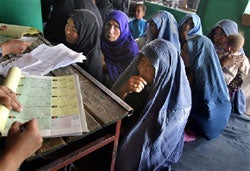Reference:
The Status of Women in Afghanistan, October 2004
- Maternal mortality: Maternal mortality rates during the
Taliban era were estimated at 1,900 deaths per 100,000 live births. The country
still has the world’s second highest maternal mortality rate, at 1,600
deaths per 100,000 live births. The eastern province of Badakshan has the
highest recorded rate in history, at 6,500 deaths per 100,000 live births.
- Women’s reproductive health awareness: 72 percent of married
women under age 50 are unaware of any methods to delay pregnancy.
- Girls’ primary school enrollment rates: Approximately
34 percent of 4 million Afghan children enrolled in school are girls.
In 10 provinces,
fewer than one out of every four girls aged 7-12 attends primary school.
Only one out of every 100 girls aged 7-12 attends primary school in Zabul
and Badghis
provinces.
- Girls attending secondary school: Of girls attending primary
school, only 9 percent continue to secondary school.
- Attacks against schools: UNICEF has confirmed 26 attacks against
schools, mostly girls’ schools.
- Literacy: The literacy rate is 14 percent for women and 43 percent
for men.
- Early marriage: Approximately 57 percent of girls get married
before the age of 16, according to a study by the Ministry of Women’s
Affairs and Afghan women’s NGOs.
- Constitutional guarantees: Afghanistan enacted a new Constitution
in January 2004. Article 22 guarantees men and women equal rights
and duties before the law. Article 44 provides that the state must promote
education for women. Articles 83-43 reserve approximately 25 percent of the
seats in the Wolesi Jirga (House of the People) for women. The president
must appoint additional women to the Meshrano Jirga (House of the Elders).
- Women’s voter registration: 41 percent of 10.5 million
registered Afghan voters are women. These figures have been inflated by
multiple registrations.
Women’s registration rates in southern provinces were significantly
lower than the national average: Zabul (9 percent), Uruzgan (10 percent)
Helmand (16 percent), and Kandahar (27 percent).
SOURCES:
On maternal mortality: Maternal Mortality in 2000: Estimates
Developed by WHO, UNICEF and UNFPA,
(Geneva: WHO, 2003). UNICEF, CDC, and Afghan Ministry of Public Health, Maternal
Mortality in Afghanistan: Magnitude, Causes, Risk Factors and Preventability (New
York: UNICEF, 2002). On reproductive health awareness: TISA,
UNICEF, Afghanistan—Progress
of Provinces: Multiple Indicator Cluster Survey 2003 (New York, UNICEF,
2004). On primary school attendance: Ibid. and TISA, ADB,
UNAMA, UNDP, and the World Bank, Securing Afghanistan’s Future: Accomplishments
and the Strategic Path Forward, 2004. On secondary school attendance: The
Human Rights Research and Advocacy Consortium, Report Card: Progress on
Compulsory Education,
Grades 1-9. On attacks against schools: “Girls’ Schools
Become Targets,” Institute for War and Peace Reporting, June 24, 2004.
On literacy: TISA, UNICEF, Afghanistan—Progress
of Provinces, 2004. On early marriage: IRIN, “Afghanistan:
Child marriage rate still high – minister. Human Rights Watch, “‘Killing
You is a Very Easy Thing For Us:’ Human Rights Abuses in Southeast Afghanistan.
See also, Amnesty International, “‘No one listens to us and no
one treats us as human beings:’ justice denied to women.” On
Constitutional guarantees: Afghan Const, arts. 22, 44, 83-4. On
voter registration: Joint Electoral Management Board, Daily Voter Registration Update,
August 26, 2004.
|

Afghan women register to vote in Kabul, July 28,2004 (Photo:
Ahmad Masood/Reuters).
|
